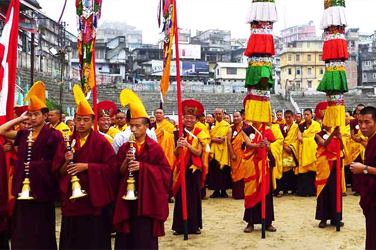Culture Of Sikkim
The people of Sikkim are warm, simple and friendly with a nature gaiety. The customs and rituals of Sikkim are as diverse as the ethnic that inhabit the land ; the 'Lepchas' — essentially children of the forest , the 'Bhutias' and the 'Nepalese'. The people of sikkim love to celebrate.

The Kingdom of Sikkim was founded by the Namgyal dynasty in the 17th century. It was ruled by Buddhist priest-kings known as the Chogyal. It became a princely state of British India in 1890. Following Indian independence, Sikkim continued its protectorate status with the Union of India after 1947, and the Republic of India after 1950. It enjoyed the highest literacy rate and per capita income among Himalayan states. In 1973, anti-royalist riots took place in front of the Chogyal's palace. In 1975, after the Indian Army took over the city of Gangtok, a referendum was held that led to the deposition of the monarchy and Sikkim joining India as its 22nd state. Meanwhile, Indian independence and its move to democracy spurred a fledgling political movement in Sikkim, giving rise to the formation of Sikkim State Congress (SSC), a pro-accession political party. The party sent a plate of demands to the palace, including a demand for accession to India. The palace attempted to defuse the movement by appointing three secretaries from the SSC to the government and sponsoring a counter-movement in the name of Sikkim National Party, which opposed accession to India. In 2000, the seventeenth Karmapa, Urgyen Trinley Dorje, who had been confirmed by the Dalai Lama and accepted as a tulku by the Chinese government, escaped from Tibet, seeking to return to the Rumtek Monastery in Sikkim. Chinese officials were in a quandary on this issue, as any protests to India would mean an explicit endorsement of India's governance of Sikkim, which China still recognised as an independent state occupied by India. The Chinese government eventually recognised Sikkim as an Indian state in 2003, in return for India declaring Tibet as a "part of" the territory of China;[45][46] New Delhi had accepted Tibet as part of China way back in 1954, but China appears to have believed that the agreement had lapsed.